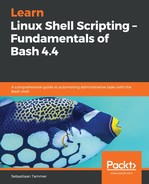After getting some background information on Linux, preparing our system, and getting an overview of important concepts for scripting in Linux, we have finally arrived at the point where we will be writing actual shell scripts!
To recap, a shell script is nothing more than multiple Bash commands in sequence. Scripts are often used to automate repetitive tasks. They can be run interactively or non-interactively (meaning with or without user input) and can be shared with others. Let's create our Hello World script! We'll create a folder in our home directory where we will store all scripts, sorted by each chapter:
reader@ubuntu:~$ ls -l
total 4
-rw-rw-r-- 1 reader reader 0 Aug 19 11:54 emptyfile
-rw-rw-r-- 1 reader reader 23 Aug 19 11:54 textfile.txt
reader@ubuntu:~$ mkdir scripts
reader@ubuntu:~$ cd scripts/
reader@ubuntu:~/scripts$ mkdir chapter_07
reader@ubuntu:~/scripts$ cd chapter_07/
reader@ubuntu:~/scripts/chapter_07$ vim hello-world.sh
Next, in the vim screen, enter the following text (note how we use an empty line between the two lines):
#!/bin/bash
echo "Hello World!"
As we explained before, the echo command prints text to the Terminal. Let's run the scripts using the bash command:
reader@ubuntu:~/scripts/chapter_07$ bash hello-world.sh
Hello World!
reader@ubuntu:~/scripts/chapter_07
Congratulations, you are now a shell scripter! Perhaps not a very good or well-rounded one yet, but a shell scripter nonetheless.
